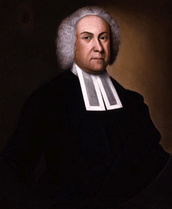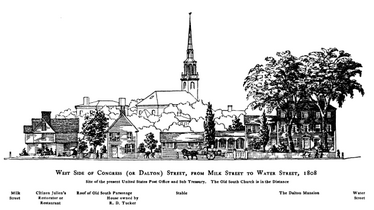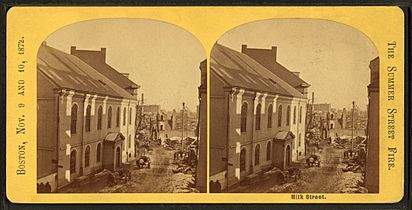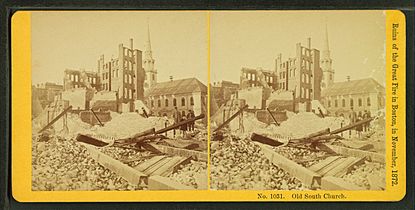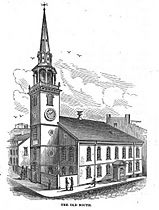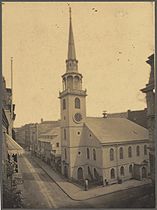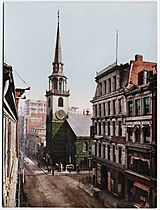Old South Meeting House facts for kids
|
Old South Meeting House
|
|
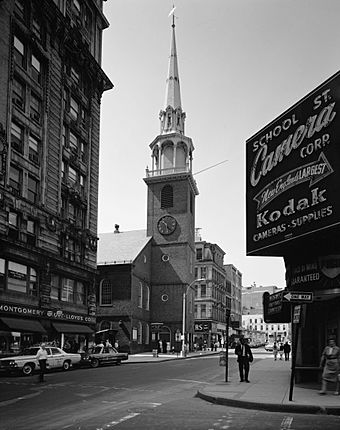
The Old South Meeting House, 1968
|
|
| Location | Corner of Washington and Milk Streets Boston, Massachusetts |
|---|---|
| Built | 1729 |
| Architect | Twelves, Robert |
| Architectural style | Georgian |
| NRHP reference No. | 66000778 |
Quick facts for kids Significant dates |
|
| Added to NRHP | October 15, 1966 |
| Designated NHL | October 9, 1960 |
The Old South Meeting House is a very old church building in Boston, Massachusetts. It was built in 1729. This famous building is located at the corner of Milk and Washington Streets in the Downtown Crossing area. It became well-known because it was the meeting place for the Boston Tea Party on December 16, 1773. More than 5,000 colonists gathered here. At that time, it was the biggest building in Boston.
Contents
A Place of History
The Church Building (1729–1872)
The Old South Meeting House was finished in 1729. It had a tall steeple that was about 56 meters (183 feet) high. The group of people who worshipped here started their own church in 1669. They separated from the First Church of Boston. The land for the church was a gift from Mrs. Norton. Her husband, John Norton, was a pastor at the First Church.
The first pastor of the Old South Meeting House was Reverend Thomas Thacher. He was also a doctor. He wrote the first medical pamphlet in Massachusetts.
After the Boston Massacre in 1770, people held yearly meetings at the church. These meetings happened until 1775. Important speakers like John Hancock and Dr. Joseph Warren spoke there. In 1773, 5,000 people met in the Meeting House. They talked about unfair British taxes. After this meeting, a group of colonists went to three tea ships. They raided the ships, which led to the famous Boston Tea Party.
The British Occupation
In October 1775, the British army took over the Meeting House. They did this because it was linked to the American Revolution. Soldiers, led by Lt Col Samuel Birch, emptied the building. They filled it with dirt and used it to practice horse riding. They destroyed much of the inside of the building. They also stole many items. One important item was a unique Pilgrim manuscript called "Of Plymouth Plantation". It had been hidden in the church's tower.
After the British left Boston, the church was rebuilt. Thomas Dawes drew the plans for the new interior.
Saving the Meeting House
The Old South Meeting House almost burned down in the Great Boston Fire of 1872. Firefighters worked very hard to save it. They knew how important the building was to Boston and the country. Fire companies from other towns came to help. After a twelve-hour fight, they put out the flames. They saved Old South and stopped the fire from spreading.
After the fire, the church group decided to move. They built a new church in a quieter area of Boston. This new church is called the "New" Old South Church. It is still there today.
In 1877, a group of twenty women worked to save the Old South Meeting House. One of these women was Mary Hemenway. She used $100,000 of her own money. They helped pass laws to protect the building. By 1910, the Old South Association took over the preservation work. The original church group still returns to the Old South Meeting House once a year. They hold a service there on the Sunday before Thanksgiving.
A Museum Today (1877–Present)
The Old South Meeting House has been an important gathering place for almost 300 years. It was famous for the protest meetings held before the American Revolution. People even called it a "mouth-house" because so many ideas were spoken there. This National Historic Landmark has always been a place for people to share their thoughts freely.
Today, the Old South Meeting House is a museum. It is open every day. It continues to be a place where people can meet and talk about important issues. The stories of the people connected to Old South show why it is so important in American history.
The museum is located at the corner of Washington and Milk Streets. You can visit it for a small fee. It is easy to get to by subway. The State Street, Downtown Crossing, and Park Street subway stations are nearby.
The Old South Meeting House is thought to be the second oldest building still standing in the United States. It is being considered for special landmark status by the Boston Landmarks Commission.
In 2020, the group that took care of Old South Meeting House joined with the Bostonian Society. They formed a new group called Revolutionary Spaces. This group now manages both the Old South Meeting House and the Old State House.
Images for kids
-
Lt Col Samuel Birch leading the 17th Dragoons in the Old South Meeting House, Boston
Gallery
-
Thomas Prince, minister ca.1718–1758; portrait by Joseph Badger (courtesy American Antiquarian Society)
See also








